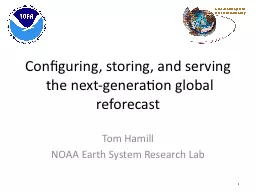PPT-Configuring, storing, and serving
Author : luanne-stotts | Published Date : 2016-03-07
the nextgeneration global reforecast Tom Hamill NOAA Earth System Research Lab 1 NOAA Earth System Research Laboratory Outline Review of DOE grant amp constraints
Presentation Embed Code
Download Presentation
Download Presentation The PPT/PDF document "Configuring, storing, and serving" is the property of its rightful owner. Permission is granted to download and print the materials on this website for personal, non-commercial use only, and to display it on your personal computer provided you do not modify the materials and that you retain all copyright notices contained in the materials. By downloading content from our website, you accept the terms of this agreement.
Configuring, storing, and serving: Transcript
Download Rules Of Document
"Configuring, storing, and serving"The content belongs to its owner. You may download and print it for personal use, without modification, and keep all copyright notices. By downloading, you agree to these terms.
Related Documents











![[FREE]-MCSA 70-697 and 70-698 Cert Guide: Configuring Windows Devices Installing and Configuring](https://thumbs.docslides.com/985733/free-mcsa-70-697-and-70-698-cert-guide-configuring-windows-devices-installing-and-configuring-windows-10-certification-guide.jpg)


